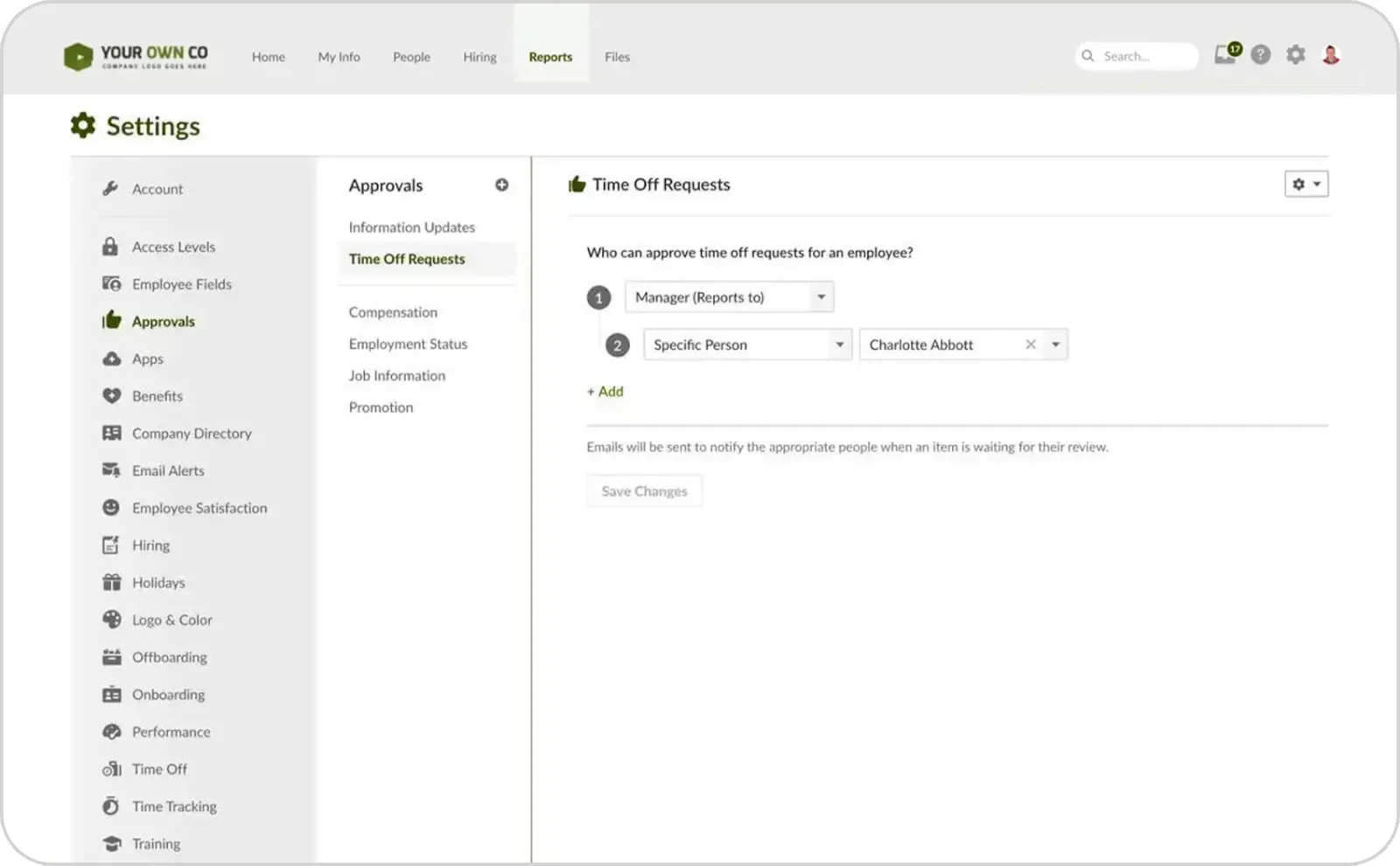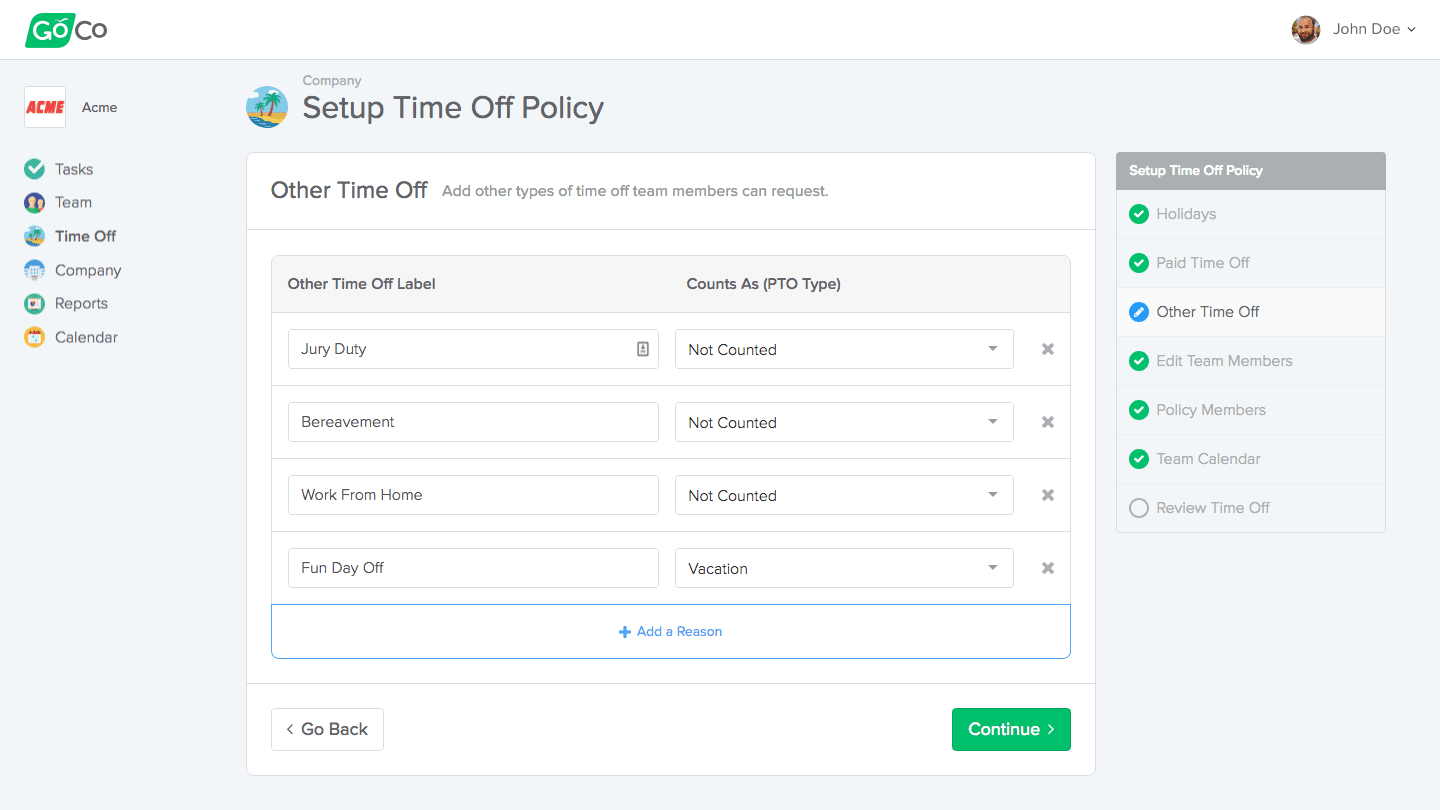HR
Time Tracking Software
Key takeaways
In this article…
What is a PTO policy?
A paid time off (PTO) policy outlines how employees accrue, manage, and use their paid time off. Unlike traditional leave policies, which typically separate paid vacation, sick leave, personal leave, bereavement leave, and parental leave, modern PTO policies combine all types of leave into one all-purpose policy. Some companies also specify paid company holidays in their all-in-one PTO policy.
No two PTO policies are the same, and determining what works best for your company is an important business decision. Your organization can set its PTO policies based on:
- Job role.
- Tenure.
- Department.
- Location.
Regardless of the details, it’s essential that you enforce your policy fairly and consistently. Otherwise, you may find yourself in the midst of legal troubles for discrimination or adverse action.
You can learn about other important human resources terms by checking out our HR Glossary.
Free PTO policy template
Need help crafting your own PTO policy? Check out our downloadable PTO policy example to get started!
Note: This template is for creating an all-in-one PTO policy. In some cases, it may be necessary to separate your leave types in your policy. You should also ensure the policy you implement complies with your employee’s state and local laws.
How to create a PTO policy
Creating a PTO policy requires collaboration between executives, human resources (HR), middle managers, and employees to determine a PTO system that is valuable to the workforce while remaining financially and logistically within the company’s reach. Whatever you decide, be sure to put the PTO policy in writing, make it accessible to all employees, and have them sign off on it upon hire and when you make any changes.
1. Identify all relevant types of leave
PTO policies can vary widely depending on your company’s preferences and regulatory requirements. For example, you may want to offer additional
The most commonly recognized types of paid leave include:
- Vacation leave for relaxation and travel.
- Personal leave for employees to take care of personal matters, such as moving to a new home.
- Sick leave* for when employees are ill or injured or are caring for ill or injured family members and cannot perform their work duties.
- Parental leave* for employees following the birth or adoption of a child.
- Bereavement: Indicates leave for employees following the death of a close friend or family member.
- Jury and witness duty: Provides leave to employees required to serve on a jury or as a trial witness.
- Unlimited: Combines all types of PTO into one, flexible policy that employees can use as needed.
2. Choose a PTO system
The second step in writing a PTO policy is establishing what does and does not count as PTO and what PTO system your company will use. The most common PTO systems are lump sum, accrual, and unlimited.
| Definition | A lump sum PTO system provides a set amount of PTO for employees to use at the beginning of a benefit year. The amount of PTO allotted will depend on your discretion and you can choose to represent it in number of hours or days. Note: Lump sum PTO systems are also known as flat-rate, frontloaded, banked, or allotment PTO. |
| Example | Employees receive 40 hours (5 days) of PTO at the beginning of your benefit year. |
| Advantages | Access to all PTO at the beginning of a benefit year. No waiting to use PTO for emergencies. Easier for employers and employees to monitor and track. |
| Drawbacks | Risk of disproportionate use of PTO at the beginning of a benefit year. May have to pay out unused PTO to employees upon separation in accordance with state laws. |
| Definition | Under an accrual PTO system, your employees will accumulate PTO throughout a benefit year based on time worked for your company. |
| Example | Employees accrue one hour of PTO for every 40 hours worked for about 52 hours of PTO in one year.OREmployees accrue PTO at a rate of 0.0192 hours for every hour worked. (0.0192 x 40 hours each week x 52 weeks in a years ? 40 hours PTO.) |
| Advantages | Employees must dedicate time to the organization before receiving PTO. More cost-effective. |
| Drawbacks | Difficult to track. More prone to errors. Puts employees at a disadvantage when they do not have accrued PTO for emergencies. May have to pay out unused PTO to employees upon separation in accordance with state laws. |
| Definition | An unlimited PTO policy allows employees to take off as many days as they need during a benefit year as long as they manage their time correctly to meet work expectations. However, there are caveats to such a system, like a more stringent approval process, advanced notice requirements, performance requirements, and waiting periods. |
| Example | For example, a publishing company can offer an unlimited PTO policy that allows employees to take as much time off as they need, provided they continue to meet their work expectations and adhere to the company’s guidelines. |
| Advantages | Attracts and retains top talent. No tracking is required. Easy administrative lift for small HR teams. |
| Drawbacks | Employees may be reluctant to use PTO with no set limit. Complicated approval process. Risk of favoritism or discrimination if not consistently and equitably enforced among all employees in the same situation. |
3. Determine employee eligibility
You can place limits on which employees are eligible for their PTO policies as a cost-savings measure. Typically, some companies base eligibility requirements on employee classification and start date.
For example, for your PTO policy, you may decide that:
- Only full-time employees are eligible for PTO.
- Part-time, seasonal, or temporary staff aren’t eligible.
- Full-time employees must satisfy a 30-, 60-, or 90-day waiting period from their start date before they can use PTO to incentivize onboarding completion.
4. Outline the approval process
Most companies require PTO approval to prevent PTO abuse. When not an emergency, a PTO request usually involves submitting a formal request for time off that is then reviewed by the employee’s direct manager or a member of the HR team for approval.
Each company’s approval process looks different, so your PTO policy should provide instructions for how employees request PTO usage.
Some questions to consider when writing your approval process include:
- How much advance notice do employees need to provide to use PTO in non-emergency situations?
- How do employees request PTO for emergencies, such as sickness or childcare issues?
- Do you require proof from employees to substantiate their need for PTO in particular circumstances, such as a doctor’s note, school note, or funeral program?
- How do employees submit a request to use PTO?
- Who approves an employee’s PTO request?
Most HR software can simplify the PTO request and approval process. For example, after an employee submits a PTO request in BambooHR, managers will receive a notification to either approve or deny in accordance with your policy. BambooHR will track employees’ PTO usage over time automatically without the need of external spreadsheets.

5. Define payout procedures
You must define when and how employees receive their PTO once approved. In most cases, employees can see their PTO on the paycheck following the date(s) they used PTO, depending on your pay period cadence. Some states, like California, also require you to keep track of employee’s PTO balances on their pay stubs.
Some employees may also have unique pay schemes, such as frequent overtime, commissions, shift differentials, bonuses, or other incentives that supplement their base pay. Because employees may rely on these payments as part of their normal paychecks, remember to indicate whether PTO payouts factor into these supplemental payments.
All-in-one HR software like Rippling can help you automate PTO calculations and avoid payroll errors. Rippling also allows managers to customize PTO policies within the platform to comply with PTO regulations both globally and domestically.
Visit Rippling
6. Explain PTO upon termination
Some states mandate employers pay out accrued PTO to employees upon termination; however, you have the choice if you are in a state with no PTO payout termination laws. Paying out PTO upon termination provides employees with a financial cushion and could strengthen company severance agreements. This gesture of goodwill can support a healthy culture of boomerang employees and enhance the company’s reputation. However, it may not be the most cost-effective option for you if you belong in high-turnover industries.
7. Consider company needs
The above steps outline the basics of most PTO policies; however, you will need to consider the needs of your business and employees to further optimize your PTO policy.
The below questions can help refine your company’s unique policy:
- How do you define the PTO benefit year: by calendar, employee anniversary, or fiscal year?
- In lump-sum or accrual PTO systems, does the amount of PTO employees receive in a benefit year increase based on company tenure?
- In lump-sum or accrual PTO systems, can employees carry over or roll over unused PTO from one benefit year to the next, or must they “use it or lose it” (if state laws allow)?
- In lump sum PTO systems, do employees receive a prorated amount of PTO if they start in the middle of a benefit year?
- In accrual PTO systems, can employees borrow against their PTO bank before accruing it?
- What’s the smallest increment of PTO that employees are allowed to use?
- Are there limitations on how much PTO employees can use at one time?
- Does your company have PTO blackout periods?
- What disciplinary actions will you take if employees do not follow PTO procedures, such as missing time after exhausting all their PTO?
8. Ensure legal compliance
Federally, private U.S. employers do have to offer PTO to their employees. That said, many states and municipalities do have their own PTO requirements, so you should have your PTO policy checked by knowledgeable legal experts before implementation. Legal experts can make sure your policy remains attractive to your employees, competitive within your industry, and compliant with all applicable government regulations.
9. Review the policy regularly
The last step before finalizing the PTO policy is receiving approval from executive management and determining how often you will review the policy. As your business’s circumstances change, your PTO benefits will also change to accommodate new or reduced revenue streams.
We usually recommend you review your PTO policy once a year. But you may decide to review and update your PTO benefits sooner following major company changes or if your workforce data indicates your current policy is the cause of employee discontent or decreased company productivity or efficiency.
10. Use software for tracking
After finalizing the PTO policy, you can leverage HR software to communicate, administer, and track your employees’ PTO. Most platforms can:
- Send PTO policies to employees to view and electronically approve.
- Track and administer PTO on employee paychecks.
- Provide a self-service portal for employees to request PTO.
For example, GoCo’s leave management tools allow you to upload and distribute your PTO policy to employees to sign electronically. In addition, employees can send PTO requests to managers and keep track of their PTO banks on their timesheets and paychecks.
HR solutions can save companies time and money and help them comply with changing federal, state, and local labor laws. Thus, even small HR teams can track and maintain a PTO policy with minimal effort.

Advantages of offering a PTO policy
Offering PTO has become a crucial aspect of modern workplace benefits. Not only does it boost productivity and job satisfaction, but it also helps in attracting top talent and reducing burnout. Here are some key advantages of implementing a PTO policy.
- Increased employee productivity: Employees return to work refreshed and more focused after time off.
- Improved job satisfaction: Offering PTO boosts morale and job satisfaction, leading to higher retention rates.
- Attracting top talent: Competitive PTO packages can attract highly skilled candidates.
- Enhanced work-life balance: PTO supports a healthy balance between work and personal life, improving overall well-being.
Drawbacks of offering a PTO policy
For some employers, the decision to offer PTO isn’t entirely within their control, as it can depend on the state in which their employees work due to varying labor laws and regulations.
Here are a few drawbacks of offering PTO:
- Increased costs: Providing PTO can increase overall labor costs for employers, especially during peak business periods.
- Potential for abuse: Employees might misuse the system, taking excessive time off and causing disruptions in workflow and productivity.
Paid time off policy FAQs
Explore our Benefits Administration Software and HR Software Guides for solutions to help manage your various paid leave policies.

About the author
